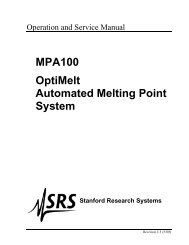Quartz Crystal Microbalance Theory and Calibration - Stanford ...
Quartz Crystal Microbalance Theory and Calibration - Stanford ...
Quartz Crystal Microbalance Theory and Calibration - Stanford ...
You also want an ePaper? Increase the reach of your titles
YUMPU automatically turns print PDFs into web optimized ePapers that Google loves.
www.thinkSRS.com<br />
Chemical <strong>and</strong> Biological Sensors<br />
Anything that has mass can generate a response from a QCM sensor. The<br />
universal response of the device is the reason for the wide range of application of<br />
the technology. However, the downside of such universal sensitivity is that you<br />
always have a great danger of interferences. For analytical purposes, it is<br />
imperative to find ways of getting the QCM sensor to respond only to what you<br />
are interested in (i.e. build sensitivity into the device). This usually involves the<br />
addition of a sensitive layer on the surface of the crystal 37 .<br />
Organic polymers comprise the most common type of coating used with QCM<br />
sensors due to their capability to reversibly sorb vapors <strong>and</strong> liquids 38 . In much of<br />
the work published on the use of polymer coatings for vapor sensing, the<br />
acoustic properties of the polymer material have been neglected. The relative<br />
importance of the mass-loading <strong>and</strong> viscoelastic contributions of the film to the<br />
observed QCM response is a subject that has yet to be resolved.<br />
In no area have the QCM applications seen such dramatic increase in recent<br />
years as in the field of biochemical analysis. QCM devices are routinely used as<br />
biochemical <strong>and</strong> immunological probes 39 , as well as for the investigation <strong>and</strong>/or<br />
monitoring of biochemcially significant processes. Sensitive, selective detection<br />
of biochemically active compounds can be achieved by employing antigenantibody<br />
40 , enzyme substrates <strong>and</strong> other receptor –protein pairs. The potential<br />
analytical uses of these materials has been reviewed, particularly with respect to<br />
the development of biochemical sensors 41 . QCM studies have provided detailed<br />
information about the functionalized surfaces developed for a range of biochip<br />
<strong>and</strong> biosensor applications.<br />
QCM Systems are applied routinely by biologists <strong>and</strong> biochemists to obtain<br />
information about processes such as: (1) protein adsorption/desorption 42 , (2) cell<br />
adhesion 43 , (3) Protein-protein interaction, (4) Degradation of polymers, (5)<br />
biofouling <strong>and</strong> biofilm formation, (6) drug analysis 44 <strong>and</strong> (7) DNA Biosensors 45 .<br />
References<br />
1<br />
G. Sauerbrey, Z. Phys. 155 (1959) 206<br />
2<br />
Daniel Buttry, “Applications of the QCM to Electrochemistry”, in A Series of Advances<br />
in Electroanalytical Chemistry, edited by Allen Bard, Marcel Dekker, 1991, p. 23-33.<br />
3<br />
John Henderson, “Electronic Devices. Concepts <strong>and</strong> Applications”, Prentice Hall, NJ,<br />
(1991) p. 357<br />
4<br />
For example, QCM10 crystal holder with a 1inch, 5MHz crystal, connected directly to<br />
an SRS QCM25 <strong>Crystal</strong> Controller.<br />
<strong>Stanford</strong> Research Systems (408)744-9040

















